Red Bay – Labrador’s World Heritage Site
This is my second post from Labrador or The Big Land as many now refer to it. It will feature the former Basque whaling station at the small community of Red Bay and include a visit to Saddle Island where much of the activity took place. It is a UNESCO World Heritage Site which is a pretty big deal because there are only just over eleven hundred and fifty worldwide. Join Alison and me in finding out why Red Bay is worthy of world wide recognition.
History of Red Bay
As a community Red Bay has had three distinct existences. The first was a small settlement of Maritime Archaic Indians who we learned about in the Port aux Choix post and then again at L’Anse Amour. Their existence here was only discovered in the 1970’s and more recent excavations have revealed an ancient cemetery site dating back 7,500 years. As noted in the Port aux Choix post nobody knows why the Maritime Archaic people who occupied Newfoundland and Labrador for a far longer period than any subsequent arrivals, simply disappeared around 2,000 years ago.
Although no doubt there were people at Red Bay between the disappearance of the Maritime Archaic people and the arrival of the Basques in the 16th century, they apparently left no archaeological evidence of significance that has been found to date. Just as the existence of the Maritime Archaic people at Red Bay was unknown until the 1970’s, so too was the existence of the Basque whaling station completely unknown until the 1970’s. Contrary to what you might think, it was not discovered by someone accidentally finding some artifact, but rather by the archaeological detective work of an amazing woman.
Selma Barkham was a Canadian historian and geographer who was a direct descendent of the famous Huxley family of England and the Lotbiniere family of Quebec, one of the oldest in Canada. By sheer coincidence, on a visit to Basque country in Spain her husband was told by a local priest that he had seen mentions in local archives of visits to ‘Terra Nova’ by Basque whaling expeditions as far back as the 1530’s. This was an astounding pronouncement as nobody knew anything of the history of European exploration and resource exploitation in Labrador between the voyages of Jacques Cartier in 1534-1536 and Samuel de Champlain’s voyages beginning in 1604. Fascinated, Barkham taught herself Spanish and then went to Spain in 1972 where after years of studying archival documents she was convinced that the priest was correct. In fact, she believed that she knew from the documents exactly where the remnants of the largest of several Basque whaling stations in Labrador could be found – Gran Baya or present day Red Bay.
In 1977, with a grant from the Royal Canadian Geographical Society she went to Red Bay and there on the mainland and nearby Saddle Island she found exactly what she was looking for – definitive proof that this had been a major whaling site. What followed was a flurry of archaeological work that in and of itself was history making. Barkham’s research had led her to believe that a significant ship had capsized and sunk in Red Bay in the 1560’s. Underwater archaeologists discovered the wreck of a galleon, probably the San Juan, exactly where Barkham had directed them to look. Also discovered was a cemetery on Saddle Island where the remains of 130 whalers who did not make it back to Spain were found.
In 1979 Red Bay was declared a National Historic Site and in 2013 it was designated as a UNESCO World Heritage Site. This is the description of why Red Bay is of Outstanding Universal Value: Situated in Labrador, in north-eastern Canada, on the shores of the Strait of Belle Isle, Red Bay was an Arctic maritime base for Basque mariners in the 16th century. It is the earliest, most comprehensive and best preserved archaeological testimony of a pre-industrial whaling station. It was used for coastal whale hunting in the summer, the butchery of the whales, and the rendering of the oil and its storage. The whale oil was sold in Europe primarily for lighting purposes. The property includes the remains of rendering ovens, cooperages, a wharf, living quarters and a cemetery, together with the underwater wrecks of vessels and whale bone deposits.
So, thanks to the efforts of one woman, in a matter of only a few decades Red Bay went from being a small fishing village on the southeast coast of Labrador to a place of universal importance. It’s an almost unbelievable story and one that must be seen to actually be appreciated as being more than just a myth and that’s what we’ll do next. BTW Selma Barkham became the first woman to be awarded the Gold Medal, the RCGS’s highest honour. She died in in 2020 at the age of 93.
Modern Red Bay is the third distinct community in the area and upon visiting the Interpretive Centre and seeing all the artifacts that have been discovered since 1977, it seems hard to believe that the present day village folk knew absolutely nothing about the existence of the Basques. The discovery of the Basque whaling station has brought tourist revenue to the area and there are even occasional visits by small cruise ships. But with a population of less than 170 people there is only one place to stay in the village. The Whaler’s Station has a variety of interesting buildings on the waterfront only steps away from the Interpretive Centre. If you can’t get a room here we recommend the Florian Hotel in Forteau which is 64 kms.(40 miles) west on the Trans-Labrador highway. There is a good restaurant at the Whaler’s Station as my son Dale can attest to with this traditional Labrador turkey dinner.
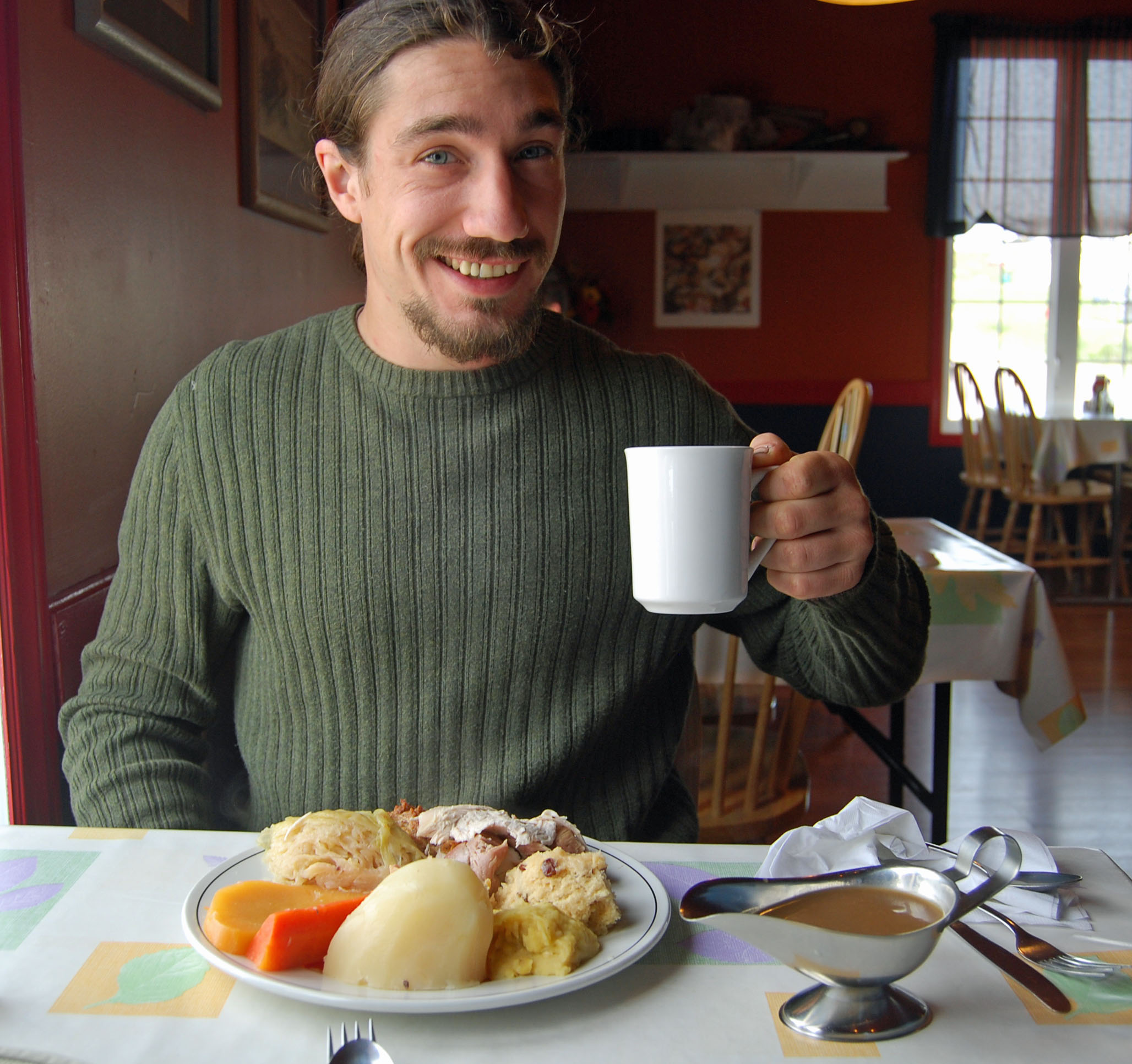
Tracey Hill Trail
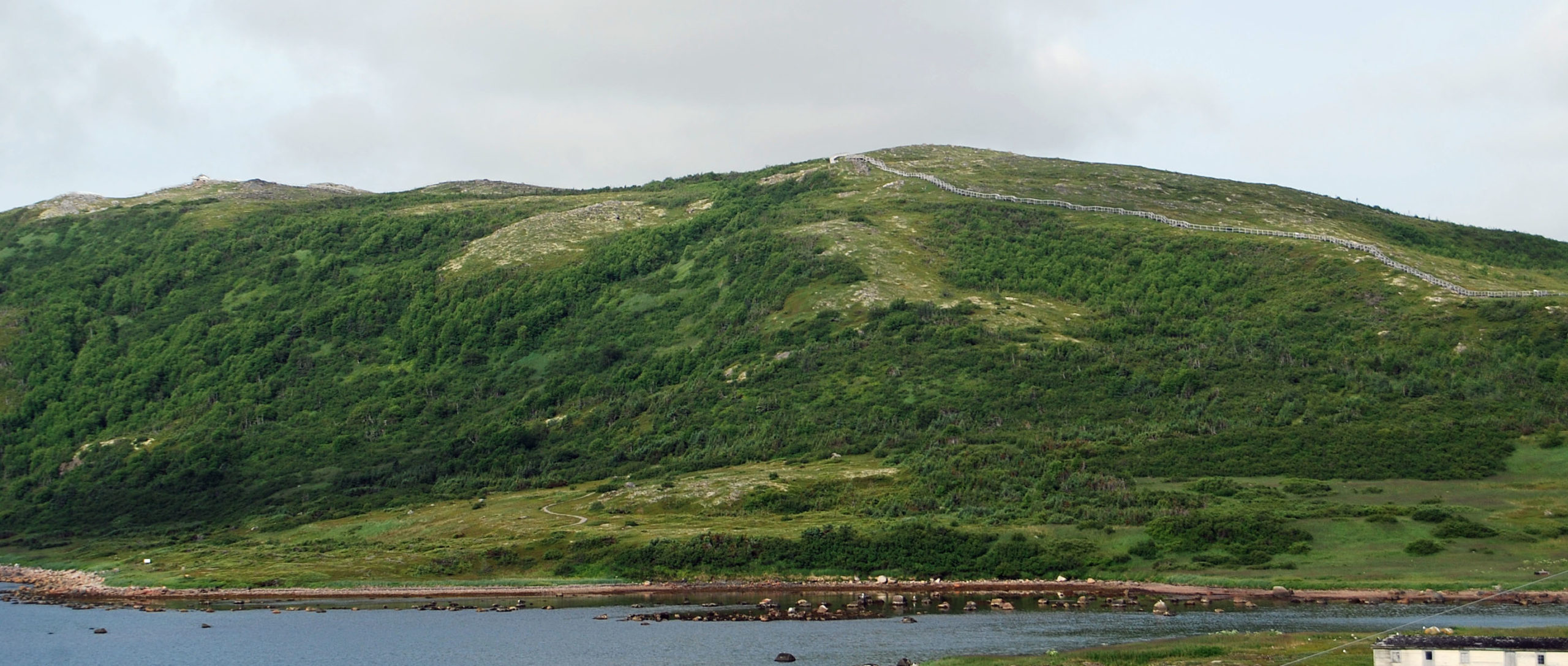
You should plan to spend at least a half day visiting Red Bay which has much more to see and do than just visiting the Interpretive Centre. The starting point should be the hike up Tracey Hill to get an overall view of Red Bay from above. The trailhead is just before you arrive at Red Bay and is actually 689 steps up to a great panorama of Red Bay and Saddle Island. Along the way you will pass a pond where the ubiquitous Captain Kidd supposedly dumped some of his loot. Why he would drag it up to here and then throw it in the water is not a question that a group of locals asked themselves as they fruitlessly tried to drain the pond some years ago.
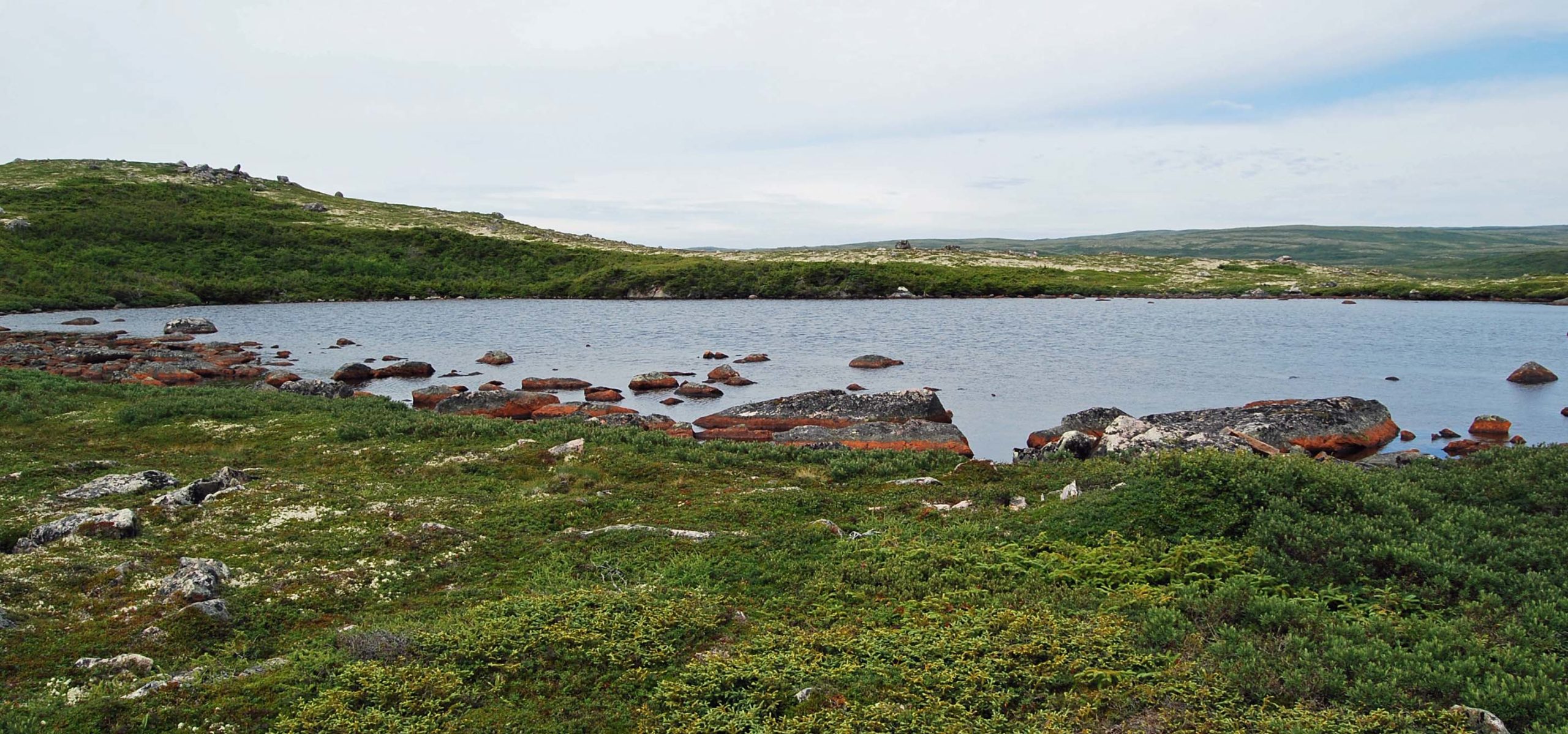
At the top there is an unusual rock formation called the American Rockyman which has been used for centuries as a lookout point for whales, icebergs and enemy warships.
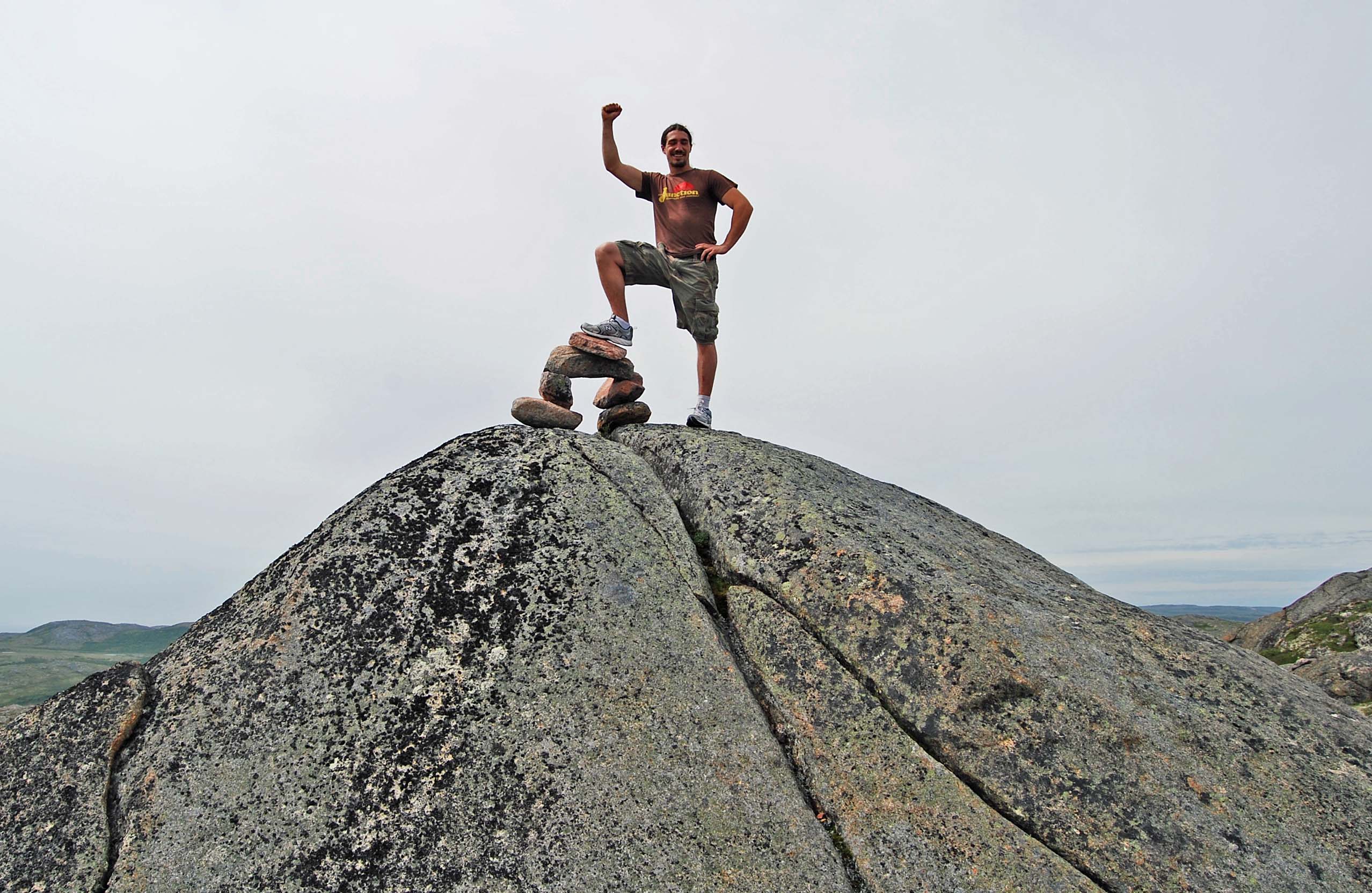
This is the view from American Rockyman with Saddle Island on the right.
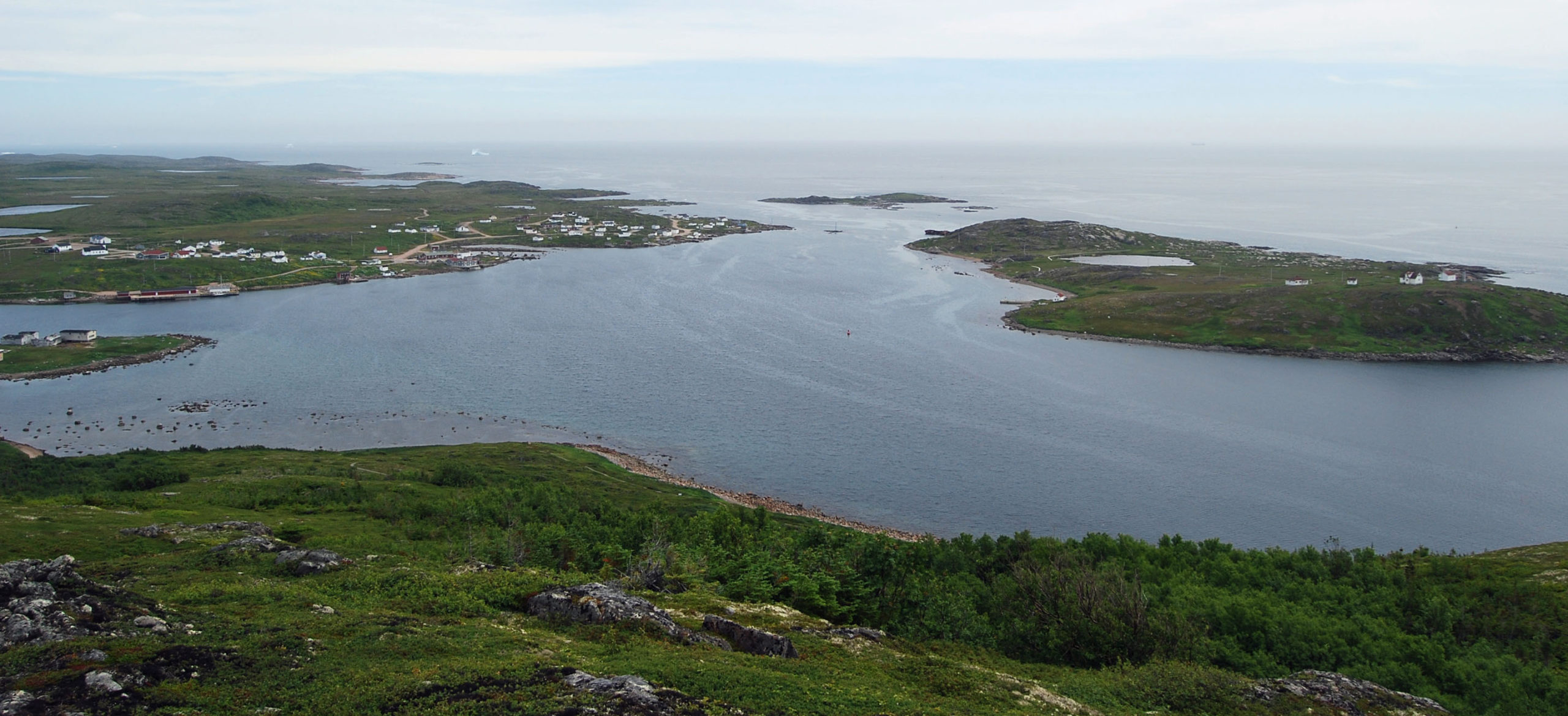
Red Bay Interpretive Centre
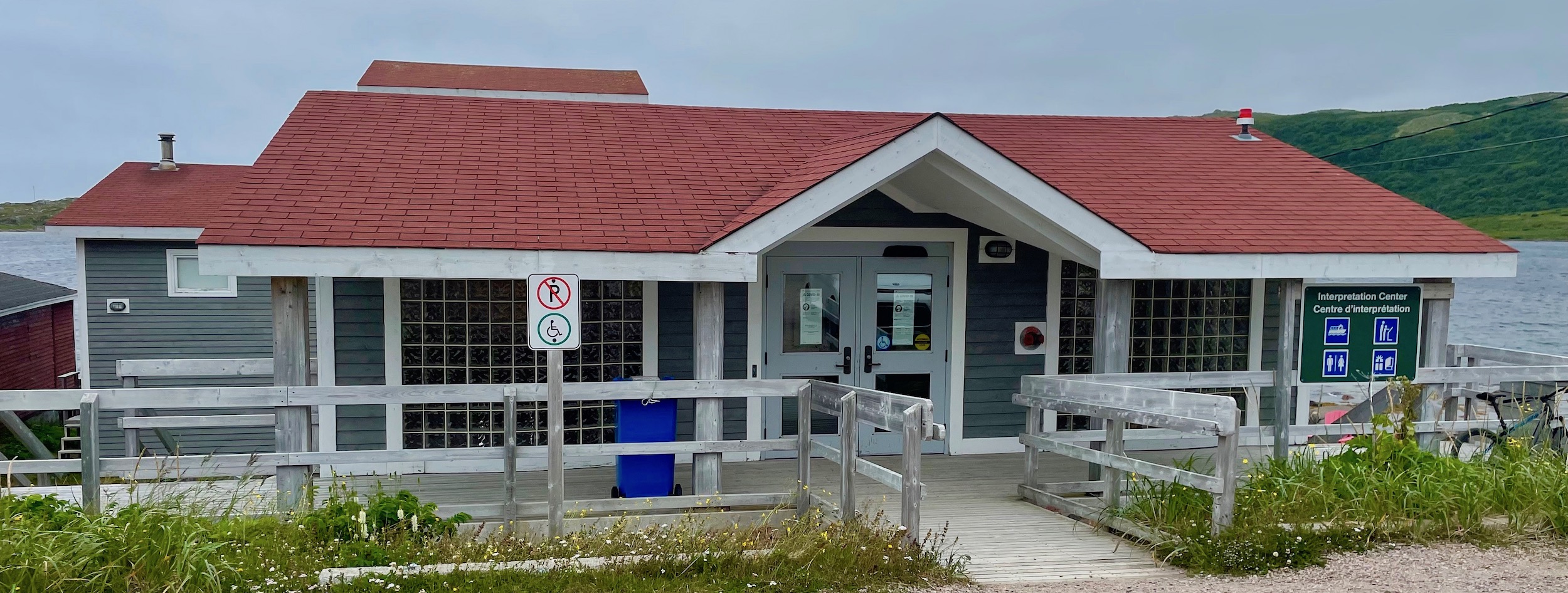
The Red Bay Interpretive Centre is not much to look at from the outside, but inside a fascinating story unfolds. Right up until the invention of kerosene by Nova Scotian Abraham Gesner in 1853, whale oil was the primary fuel used in lighting in Europe and North America. Although Indigenous people have been hunting whales for millennia, it was the Basques in the 11th century who first made it into a commercial industry.
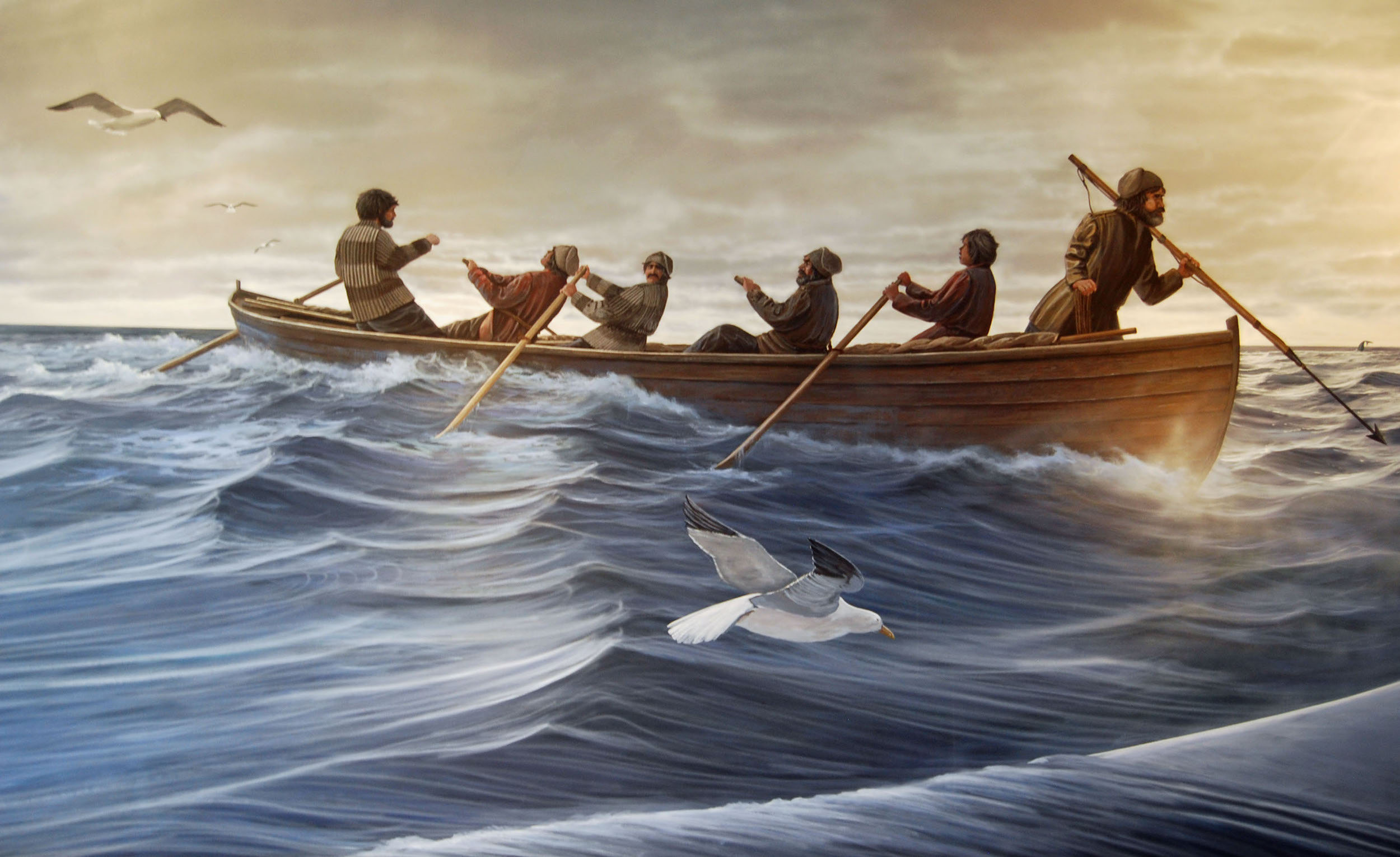
Followed by the Dutch and the British, it did not take long to deplete the stocks within the Mediterranean and eastern Atlantic so the Basques were always looking for new hunting grounds. When John Cabot brought back news of the fabulous cod stocks of the Grand Banks in 1497 it did not take the Basques long to start an annual pilgrimage to the waters off Newfoundland. It is believed that as an offshoot of the cod fishery they also started taking a few whales. By the time Jacques Cartier sailed through the Strait of Belle Isle in 1534 he encountered many seasonal Basque whaling stations including present day Red Bay.
Red Bay operated as a Basque whaling station for about seventy years hunting primarily the northern right whale, so-called because it was the best or the ‘right’ whale to pursue, and the bowhead aka Greenland right whale.
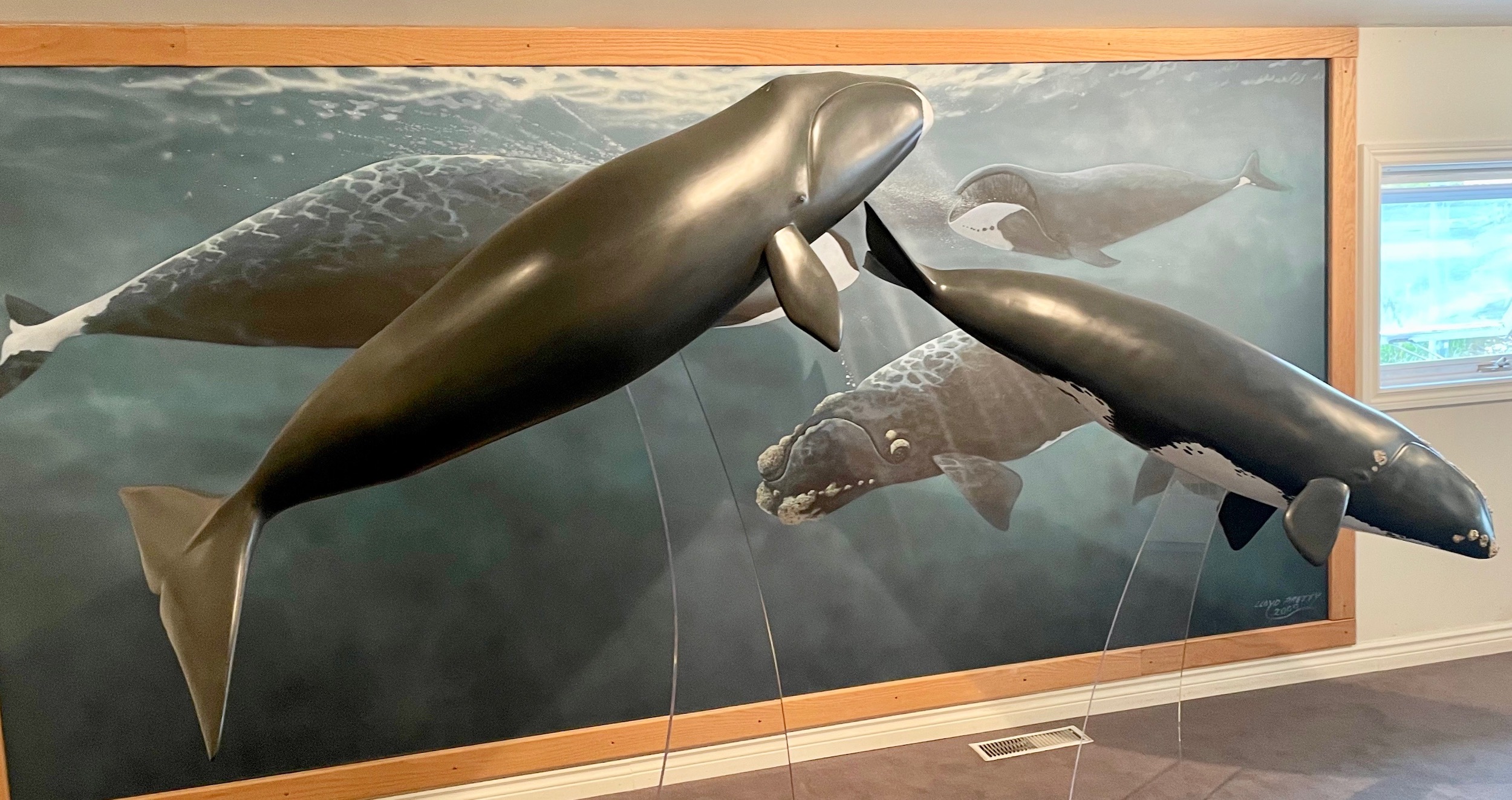
Unlike later whaling techniques which involved large ships from which smaller boats were launched in pursuit once a whale was spotted, the Basques at Red Bay relied upon the whale’s predictable migration routes to help them. They would spot them from land on places like Tracey Hill and relay the information to crews on shore who would row a boat called a chalupa in pursuit, much as shown in the mural above.
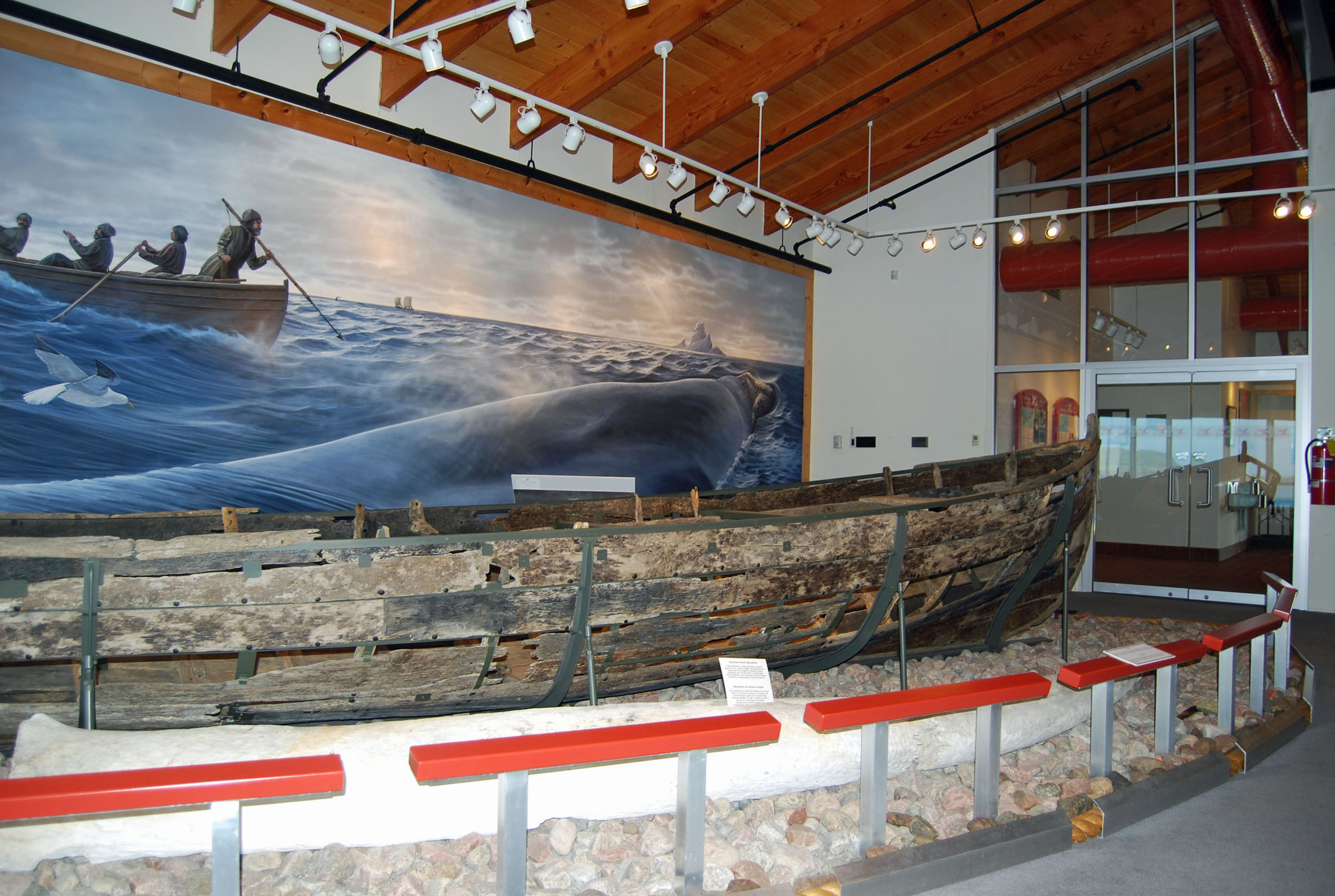
Remarkably, the well preserved remains of a chalupa were found in the waters of Red Bay once extensive underwater archaeology by Parks Canada began here. The waters of the Strait of Belle Isle are very cold which explains why wood, which rots away in warmer waters, stays reasonably intact here for centuries.
Once the whales were killed they were taken to a rendering station of which the best preserved was found on Saddle Island. After the skin was stripped the flesh was rendered in pots like these. Once that was complete the oil would be stored in barrels and the holds that were laden with supplies on the way over would be full of a very valuable cargo on the way back.
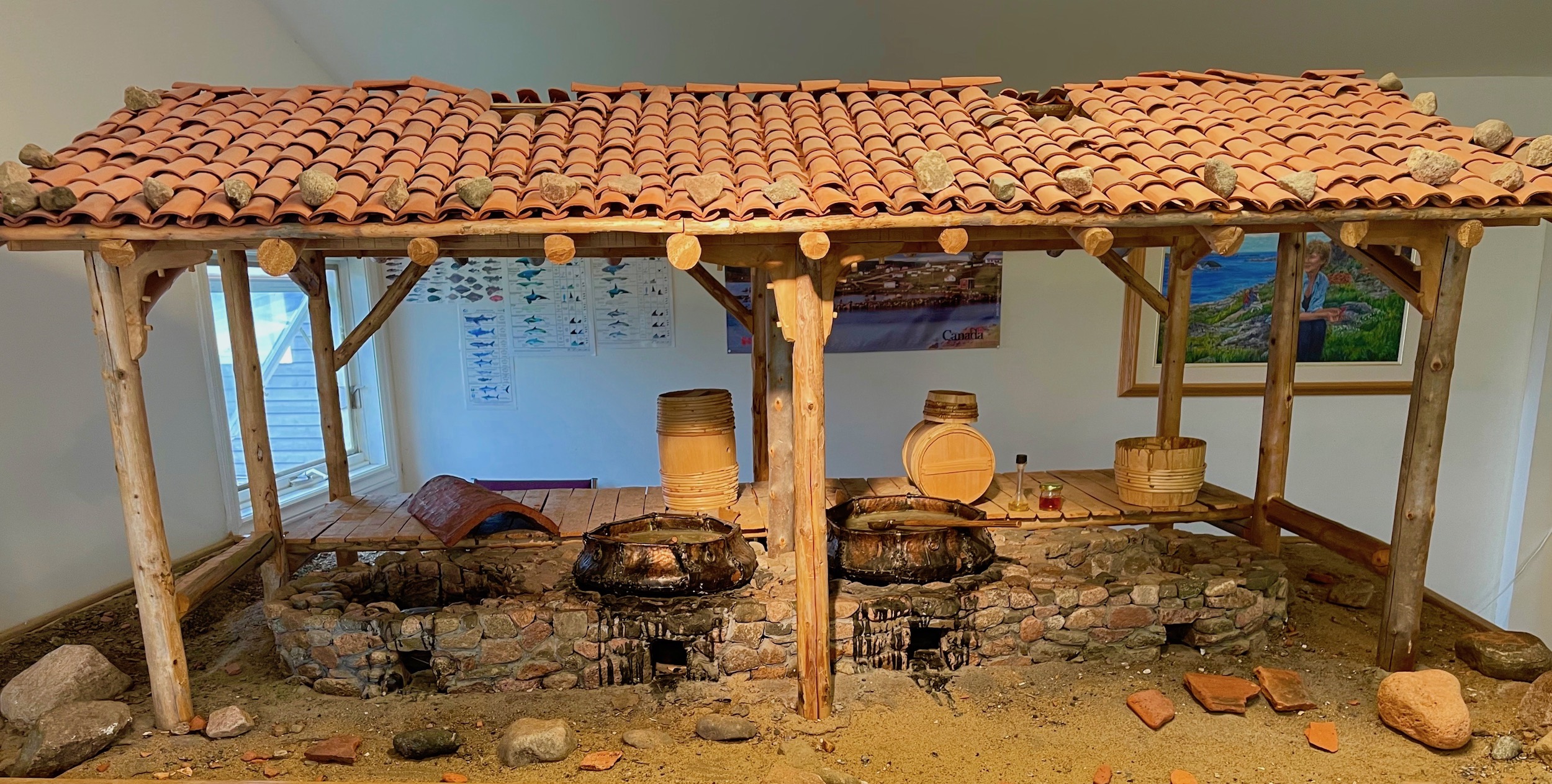
Even more amazing than the finding of the wooden chalupa are the discoveries of four Spanish galleons in the Red Bay area, starting with the San Juan in 1977, two more in 1980 and a fourth in 2004. The San Juan is Canada’s oldest known shipwreck. This is a replica found in the Interpretive Centre.
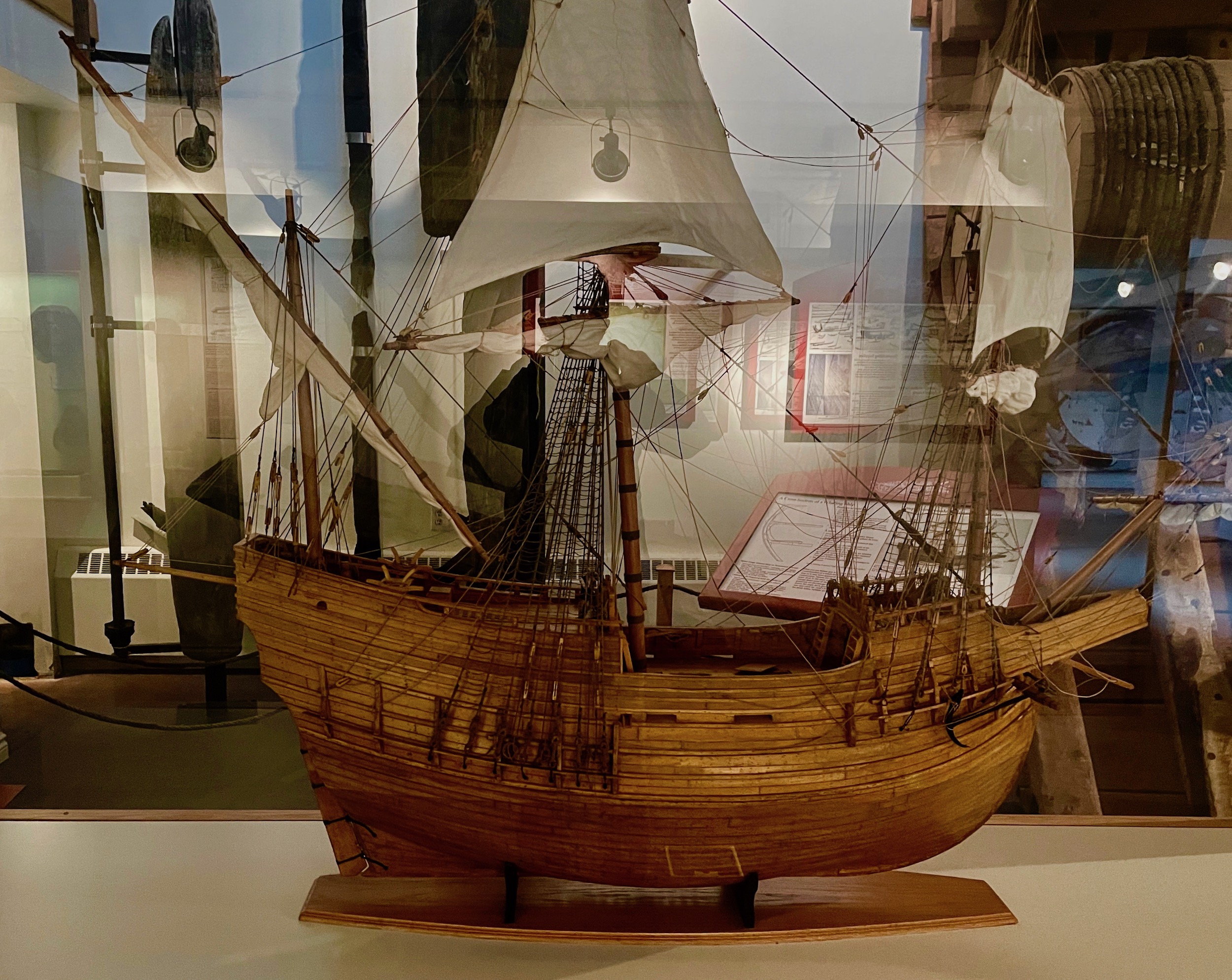
These are a few of the artifacts found both on and mostly offshore at Red Bay including these very rare navigation instruments.
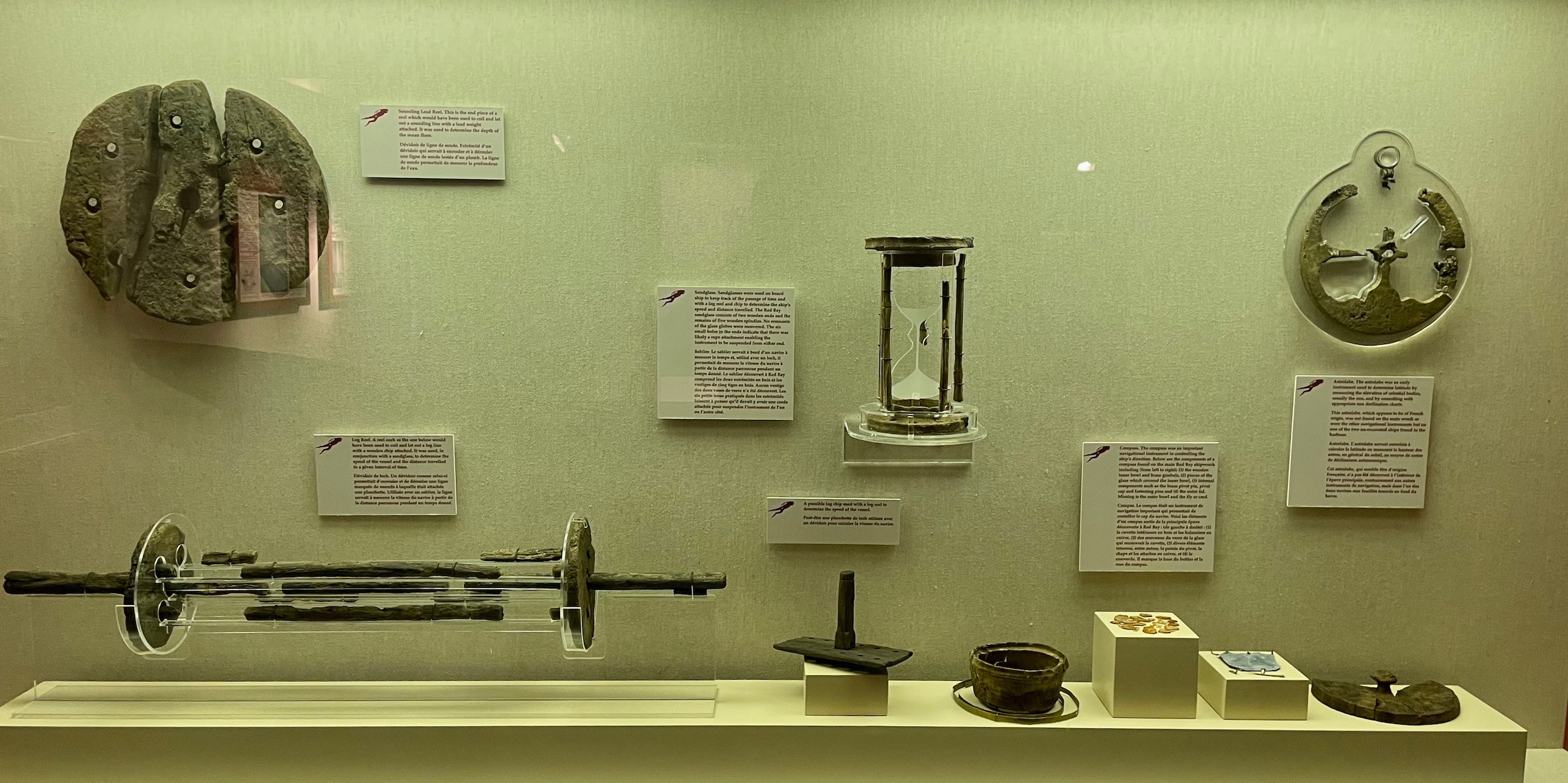
And these various block and tackles that would never have survived in the warm Caribbean waters where most Spanish galleons were shipwrecked.
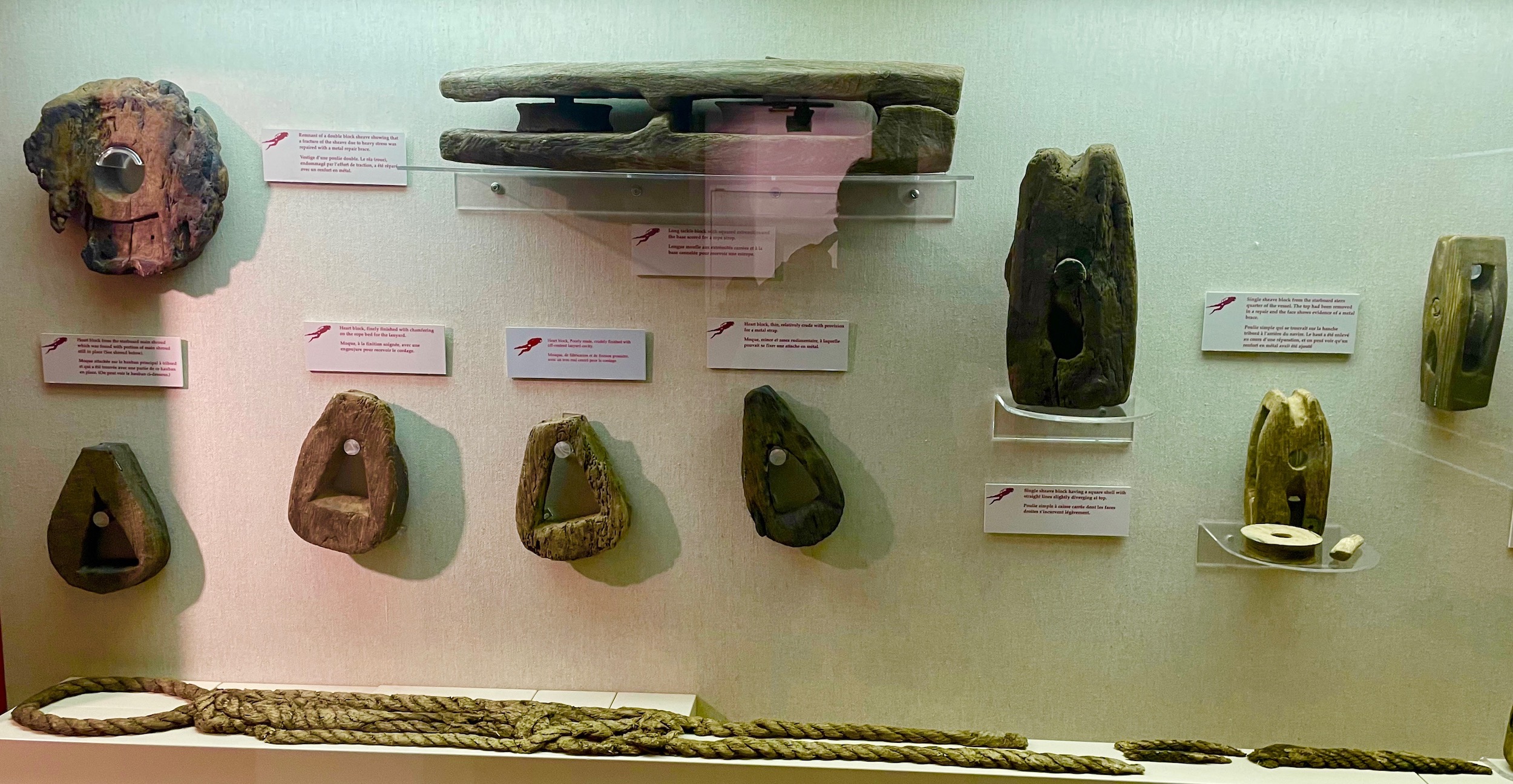
When I think of Spanish galleons I think of the Spanish Main and the pirates of the Caribbean (the real ones, not the movies). As a Canadian it is amazing to learn that the best preserved of these world famous ships is found in our waters and who knows how many more remain to be found.
Aside from the artifacts and displays related to the whaling and the ship wrecks the Interpretive Centre delves into the day to day life of the Basque whalers, guided with much assistance from examinations of the bodies excavated from the cemetery on Saddle Island. Like the cold water, the peaty soil of the island has left much of the clothing worn by the deceased Basques in remarkable condition like these whaler’s boots.
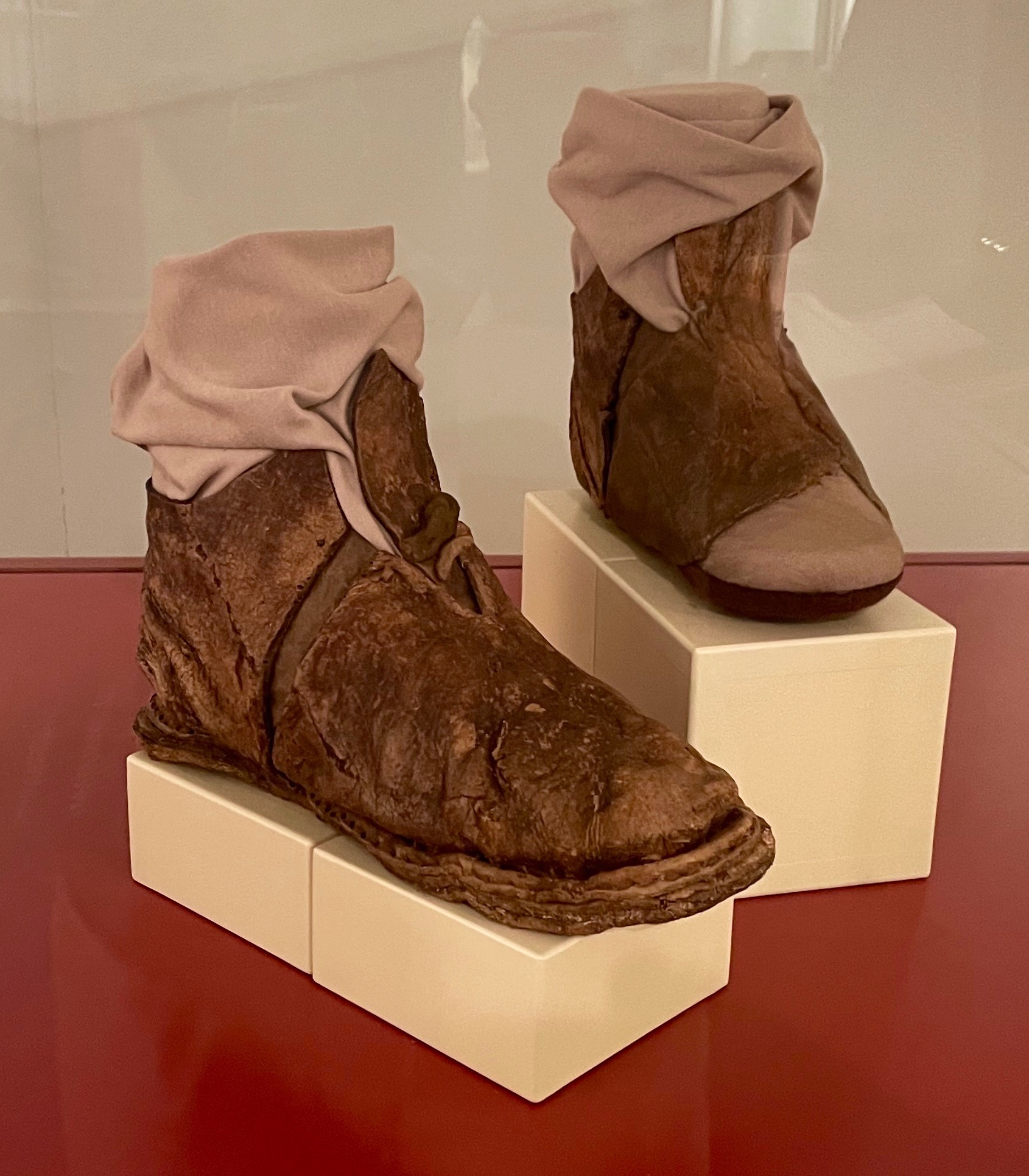
The excavations at red Bay have given archaeologists a pretty good idea of what these men, long dead centuries ago, looked and dressed like. Here is Alison with two of them.
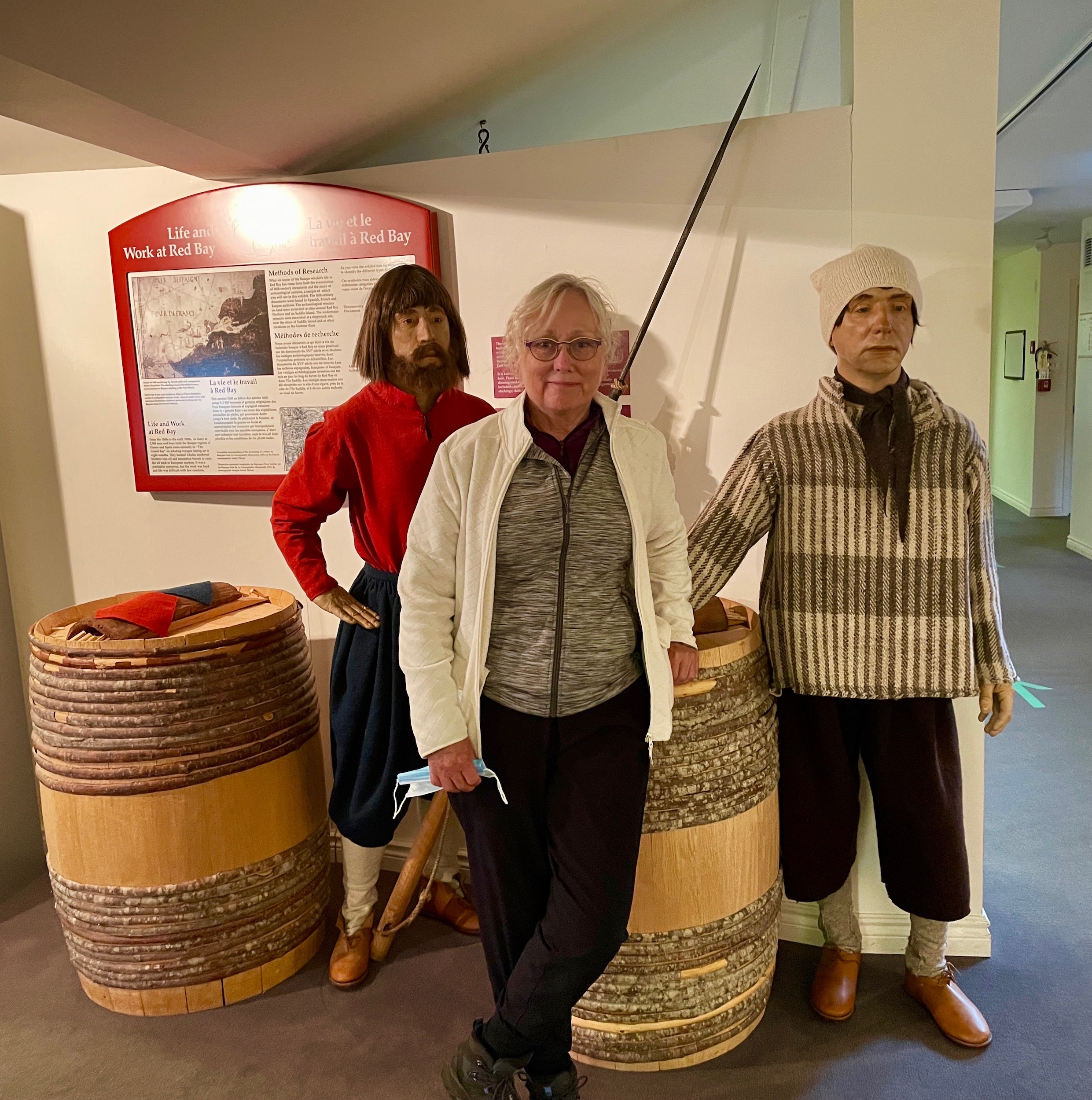
Before leaving the Interpretive Centre keep on eye out for this hooked rug which is a tradition in Newfoundland and Labrador.
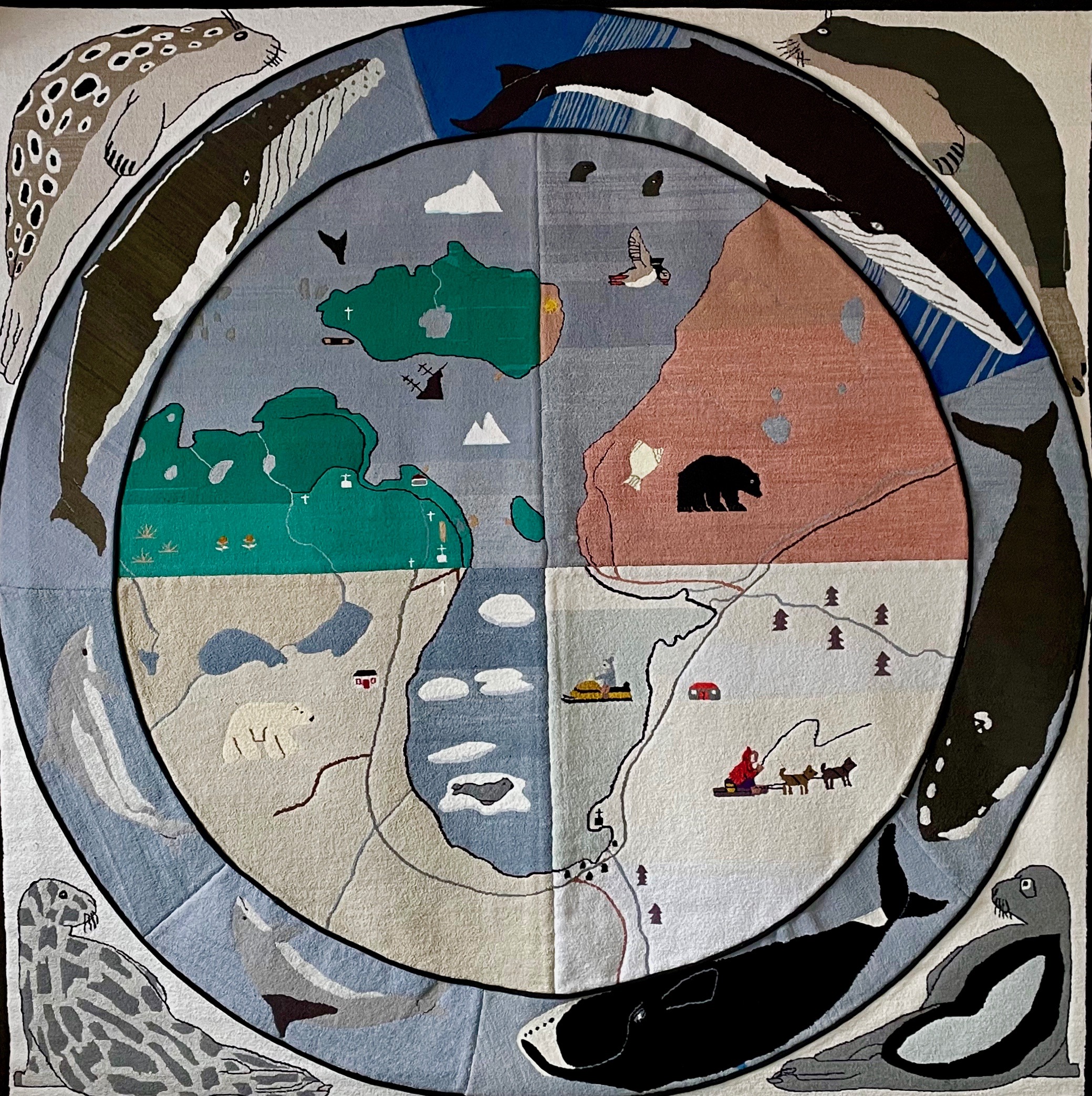
Saddle Island
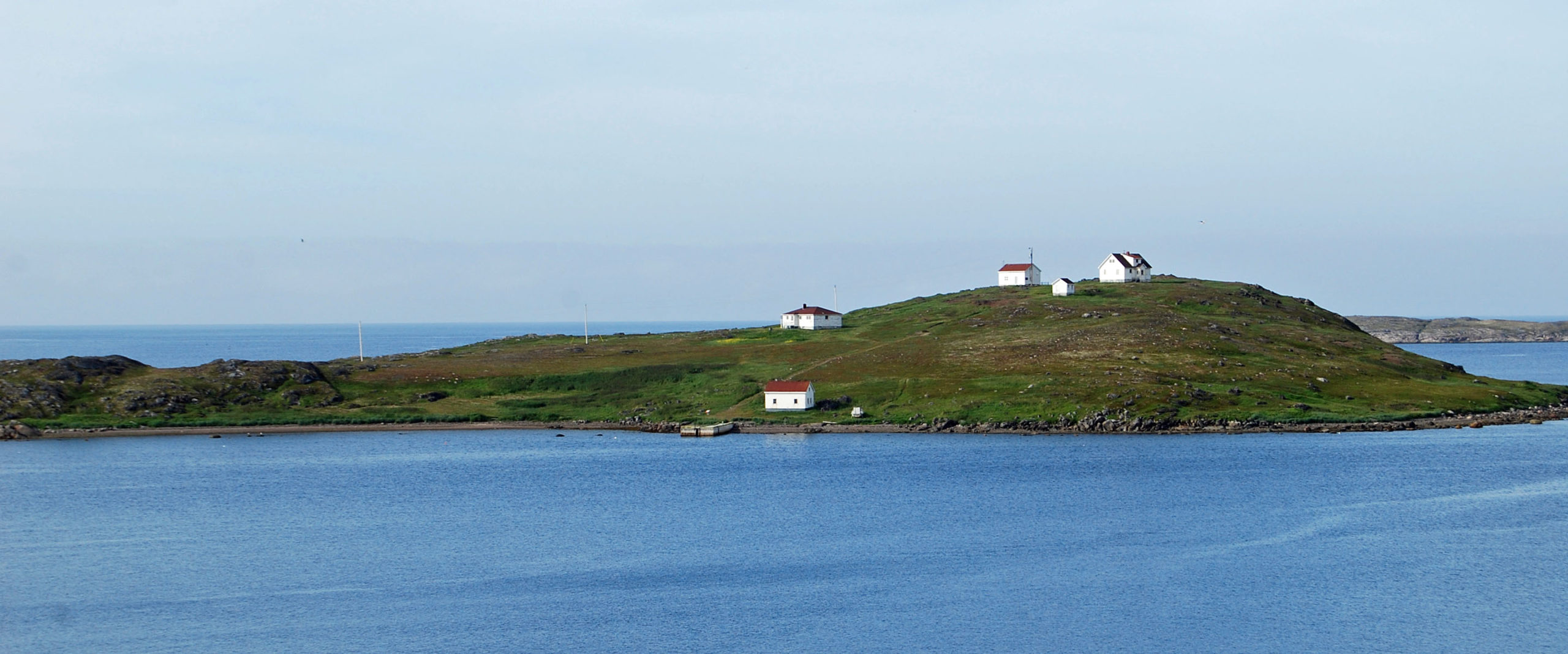
Although it was not operating in 2021 due to Covid, the Parks Canada ferry to Saddle Island should be back in service by next year and if it is, it is an important part of any visit to Red Bay. It was on Saddle Island that most of the processing was done and also the site of the cemetery. What follows is based on my first visit with my son Dale a few years before.
It’s a short, but interesting trip to the wharf you can see in the photo above. On the day we went there there were gannets dive bombing capelin which is an amazing site. Once on land there is a trail to the the rendering sites, the cemetery and other sites.
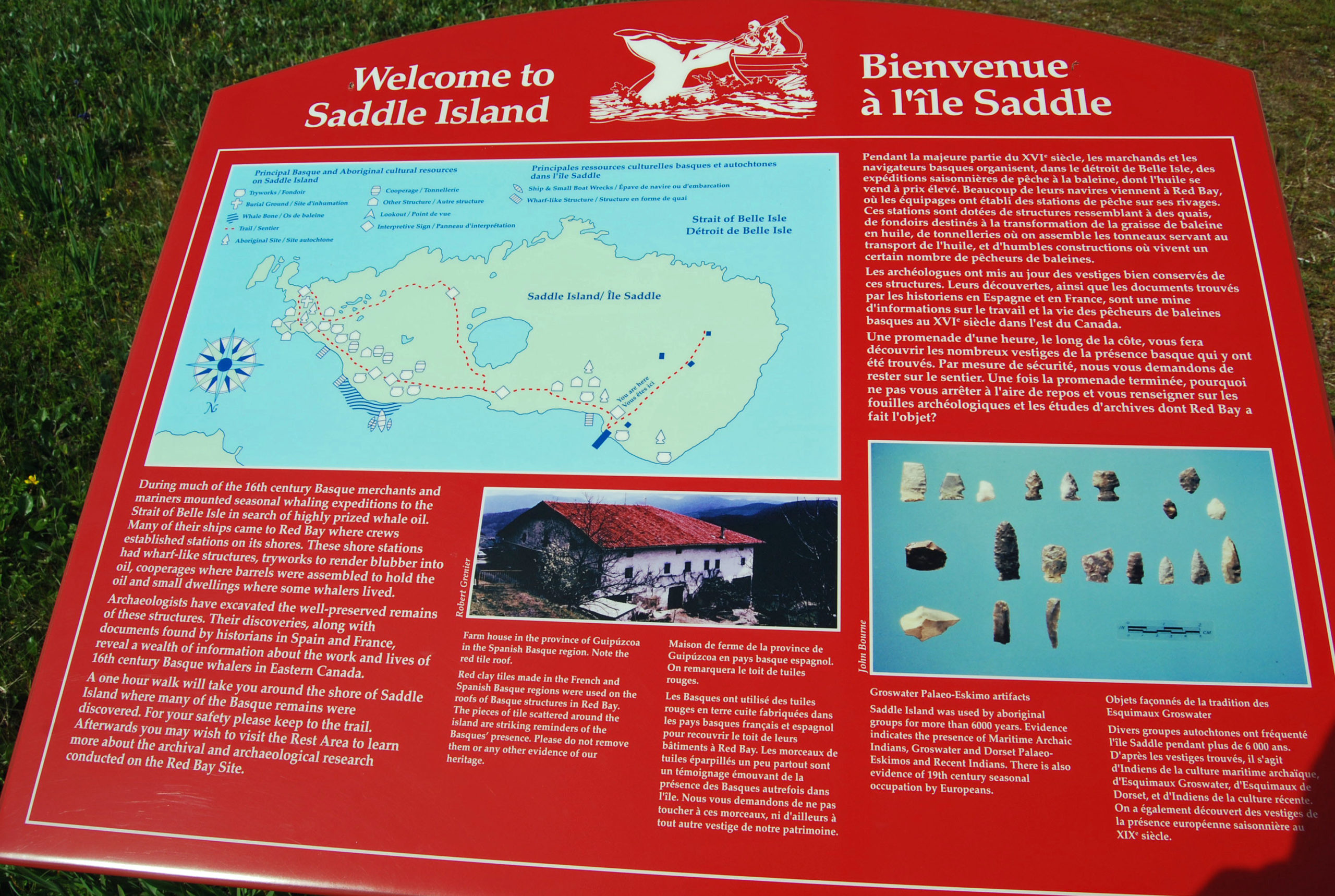
Offshore you’ll see the wreck of the Bernier which sank in 1960, proving that Red Bay is still claiming ships some four hundreds years after the San Juan.
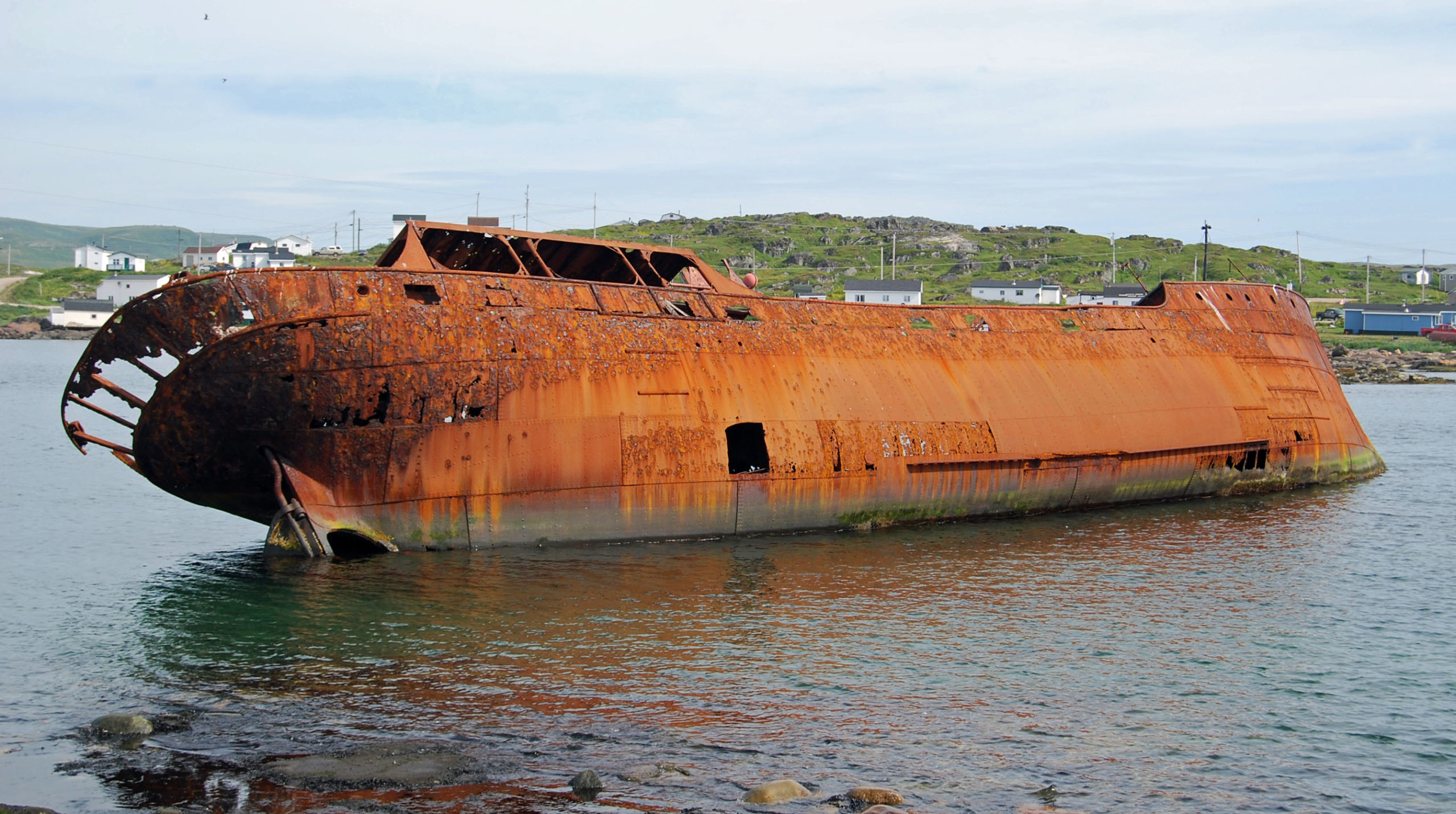
This is the view of Red Bay from Saddle Island.
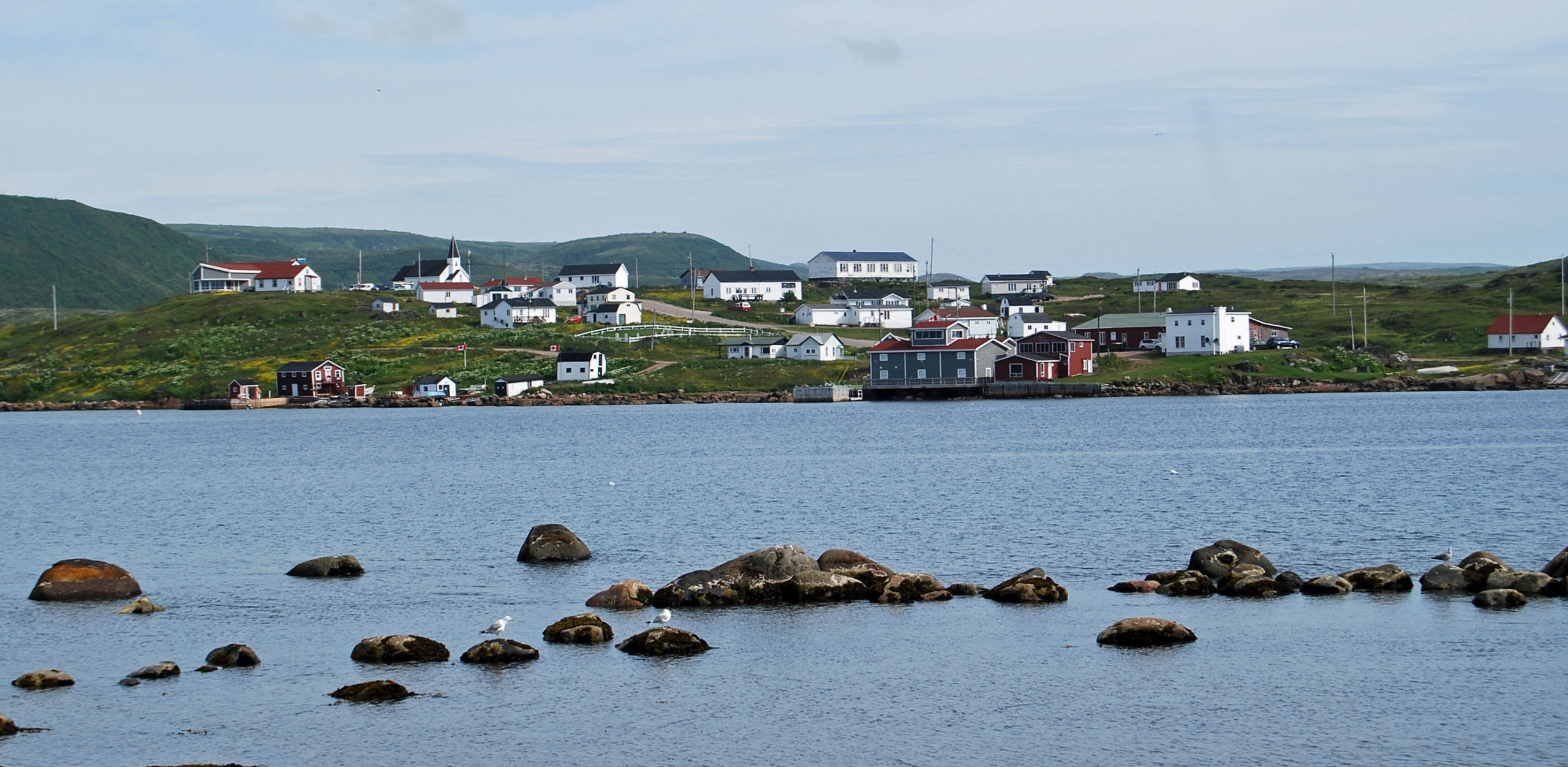
Back on the mainland your visit to Red Bay is almost over, but you must sit in one of those iconic Parks Canada red chairs and contemplate this place that was only discovered through hard work in the dusty archives of a country thousands of miles away.
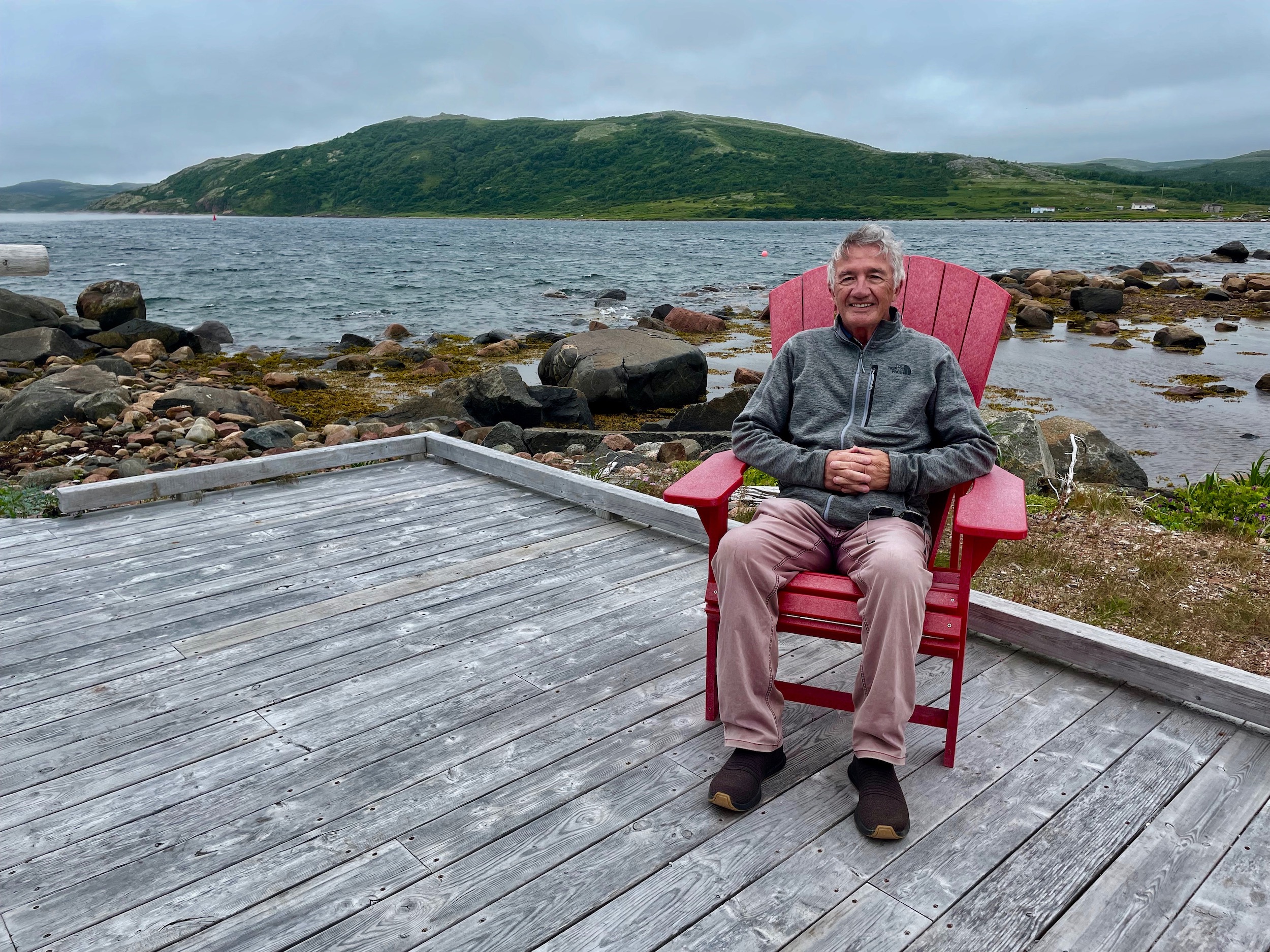
In the next post we’ll take to the water again to spend two days at Labrador’s top tourist attraction, Battle Harbour. Please join us.

